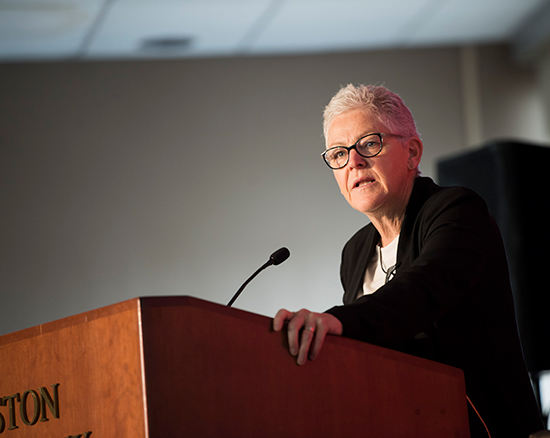SPH Hosts Climate Change Symposium
Policymakers, journalists discuss cities, the media, and climate solutions

The signs are grim, and grimly familiar: 2016 was the hottest year on record since 1880, future warming is inevitable, and by the end of the century, Boston may see entire summers with daytime temperatures over 90 degrees Fahrenheit. Extreme rainfall is forcing migration worldwide. West Nile virus is increasing in Los Angeles county. And 2017 saw the worst wildfires in California history.
Despite this dire litany, when former Environmental Protection Agency administrator Gina McCarthy addressed the students, academics, communicators, and policymakers gathered at the School of Public Health last Friday, she delivered a forceful and unexpected message: “Stop looking so mopey! Nobody follows a mope,” she said. “This is a time of change, and every time of change means there are massive opportunities. I am grabbing them and you can too.”
McCarthy was the keynote speaker at a daylong SPH symposium called Changing the Climate: How Public Health, Cities, and the Media Can Advance Climate Solutions. The school convened the symposium, which was cohosted with the Pulitzer Center, to bring together thought leaders from public health, government, and journalism to share solutions to the global climate challenge, and to discuss ways to bring greater attention to the issue. Other collaborators were the BU Initiative on Cities, Center for Climate, Health, and the Global Environment at Harvard T. H. Chan School of Public Health Innovate@BU, and Sustainability@BU.
McCarthy’s surprisingly optimistic message noted that changes needed to address climate change will create jobs, add stability to the world, and reduce “traditional” air pollution. “This is not a struggle or a trade-off, this is how you save the planet and our kids,” she said. “We can make the world healthier and more prosperous as we move away from fossil fuels.”
And, she added, “We can use climate change as momentum to get the investment in public health that we’ve been bitching and moaning about since day one.”
Other speakers also voiced optimism, some of them focusing on the critical role of states and cities in the absence of federal or global leadership. Several speakers noted that cities have moved to the forefront on climate change action, for several reasons: most of the world is now urban, cities are responsible for a disproportionate share of carbon emissions, city dwellers are vulnerable to climate extremes, and city governments tend to be less politicized than their federal counterparts.
“Mayors by nature are practical because we’re responsible for real things that affect people’s everyday lives,” said David Miller, former mayor of Toronto. “I’m an optimist on climate. Not only do we know where the emissions are, we know what to do about them.”
“This is not a struggle or a trade-off, this is how you save the planet and our kids,” she said. “We can make the world healthier and more prosperous as we move away from fossil fuels.”—Gina McCarthy
Miller said that most cities’ emissions come from four sources: the electric grid, the heating and cooling of buildings, transportation, and waste management. “If we can control these things, we can mitigate climate change and also make cities better places to live,” he said, noting that heating and cooling aging buildings accounts for 70 percent of Boston’s emissions, and 60 percent of Toronto’s. “How we heat and cool old buildings is going to decide whether most cities are able to meet their carbon reduction goals.”
Austin Blackmon, Boston’s chief of environment, energy, and open space, focused on the city’s plans to cope with rising sea levels. “Four hundred years ago, 30 percent of Boston was under water,” said Blackmon. “Over the past 100 years, we have already seen about 10 inches of sea level rise.”
He described how Imagine Boston 2030, Boston’s first citywide plan in more than 50 years, took environmental justice into account. For instance, adding greenspace to East Boston that doubles as floodplain would increase the neighborhood’s resilience against sea level rise, while also adding outdoor space that would contribute to community health.
Speakers and panelists also discussed the best ways to communicate information about climate change to the public, arguing that public health—caring for children, the elderly, and other vulnerable groups—may offer common ground and shared values. Speakers also noted the importance of reaching the public by focusing on people, stories, local issues, and solutions. “People who accept the science and want to act feel kind of paralyzed,” said Miller.
Hannah Fairfield, New York Times climate editor, described a recent Times series about cities and climate change, which was written by the paper’s chief architecture critic. Fairfield was surprised by readers’ response to the series, which heavily favored a story about Rotterdam, a city that she described as “half underwater” and looking for solutions. “Now the city is making money by exporting their solutions,” she said, and readers responded to the positive message.
Fairfield added that it’s important to talk about what individuals can do. “So many of the solutions we see are big solutions. They are policy solutions,” she said, noting that purchasing better consumer electronics—more energy-efficient air conditioners, for instance—is one way that individual people can make a difference. “Not many of us are lucky enough to be policymakers,” she said. “But we are all consumers.”
This BU Today article was written by Barbara Moran.